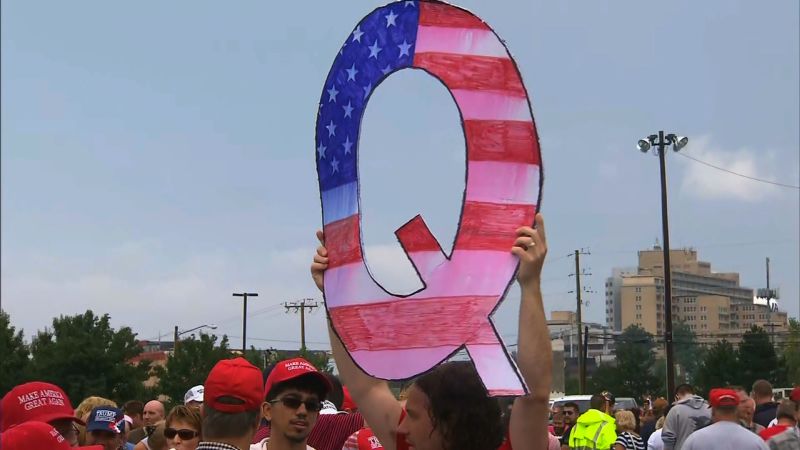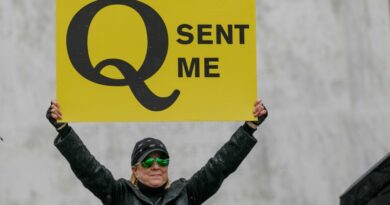What is QAnon?

Since its origin three years ago, QAnon has festered in the darker corners of the internet. Now the group’s followers, who call themselves “believers,” have found a niche on social media and within the Republican Party.
QAnon began as a single conspiracy theory. But its followers now act more like a virtual cult, largely adoring and believing whatever disinformation the conspiracy community spins up.
Its main conspiracy theories claim dozens of politicians and A-list celebrities work in tandem with governments around the globe to engage in child sex abuse. Followers also believe there is a “deep state” effort to annihilate President Donald Trump.
But followers of the group have expanded from those beliefs and now allege baseless theories surrounding mass shootings and elections. Followers have falsely claimed that 5G cellular networks are spreading the coronavirus.
There’s no evidence that any of what QAnon claims is factual.
Followers make unfounded claims and then amplify them with doctored or out-of-context evidence posted on social media to support the allegations.
The anarchical group’s birth, and its continued seepage into mainstream American life, comes on the coattails of the Russian disinformation campaign that targeted US elections in 2016.
While the Russian campaign had an apparent objective – influence voters to elect Trump – QAnon is decentralized, having no clear objective aside from its popular slogan, “Question everything.”
Anyone can create a conspiracy, offer evidence to support it and tag it with QAnon hashtags to spread it. But no one is held responsible for the trail of chaos and disinformation it leaves behind.
How QAnon began
QAnon’s origins are emblematic of what it has evolved into: An unfounded, out-of-context claim made to support an allegation, which is easily discredited.
It all goes back to a cryptic, anonymous post on October 28, 2017 on 4chan, an online message board that frequently features extremist and bigoted content. The individual, which followers would later call “Q,” claimed that Hillary Clinton was going to be arrested.
There was no arrest.
But similar posts pushing baseless claims of arrests and “deep state” action kept appearing on 4chan. It’s unclear who was behind the posts, or if the ones that followed were posted by the same person – 4chan posts are anonymous.
Believers claim that their “Q” is so knowledgeable because of their claim to security clearance within the US government.
QAnon supporters have likened the initial posts, and subsequent ones, to Hansel and Gretel-like breadcrumbs, or “drops,” as they call them now.
Since then, the group has injected itself into the mainstream by creating communities on Reddit and finding footholds on Twitter, Facebook and YouTube. In a series of videos posted online in 2018, QAnon targeted Cemex, a Mexican cement company, because it reportedly owned an abandoned camp in Arizona, which conspiracy theorists erroneously believe is the location of a human trafficking site.
Earlier in 2020, Oprah Winfrey and Tom Hanks were both targets of QAnon conspiracies.
At the time, CNN reached out to Cemex and representatives for Tom Hanks and Oprah Winfrey but never received a response.
Believers claimed on several social media sites that a Boca Raton, Florida, house belonging to Oprah was seized by police in a child sex trafficking sting and roped off with red tape.
Another person on Twitter made a post, which garnered thousands of shares, falsely claiming that Tom Hanks, who tested positive for coronavirus in Australia, was actually arrested for pedophilia. The post said that other A-list celebrities would soon be arrested.
QAnon conspiracy theories have been further elevated through high-profile figures and organizations. In March 2018, before being fired from her sitcom, actress Roseanne Barr tweeted about the pedophilia conspiracy theory, alluding to a baseless claim that President Trump “has broken up trafficking rings in high places everywhere.” Barr later deleted the tweet.
The GOP and QAnon
QAnon nearly reached the main stage of the Republican Party at President Trump’s July 31, 2018 rally in Tampa, Florida, where signs reading “We are Q” and “Q” appeared near the front of the crowd during the President’s speech.
Four months later, Vice President Pence posted – and then deleted – a photo on Twitter with a law enforcement officer wearing a QAnon patch on his uniform.
And in July 2019 the White House invited a QAnon supporter to an event billed by the White House as a “social media summit” with conservative influencers.
Today the GOP has three candidates that have been sympathetic or supportive of the group and could see themselves in Congress in January: Jo Rae Perkins, a candidate for a US Senate seat in Oregon; Marjorie Taylor Greene, a Congressional candidate for Georgia’s 14th district seat; and Lauren Boebert, who beat a Trump-backed, five-term incumbent during primary elections to become a candidate for Colorado’s 3rd district.
“Everything I heard of Q – I hope that this is real because it only means America is getting stronger and better, and people are returning to conservative values, and that’s what I am for,” Boebert, the front runner for the House seat, said in a May interview.
Her campaign manager, Sherronna Bishop, told CNN in a statement that despite those comments, Bishop “does not follow QAnon.”
CNN has reached out to the Republican National Committee and President Trump’s campaign for comment on QAnon and the GOP candidates’ comments on the group but has not heard back.
CORRECTION: An earlier version of this story misstated the date of a Trump rally in Tampa, Florida. It was held July 31, 2018.

